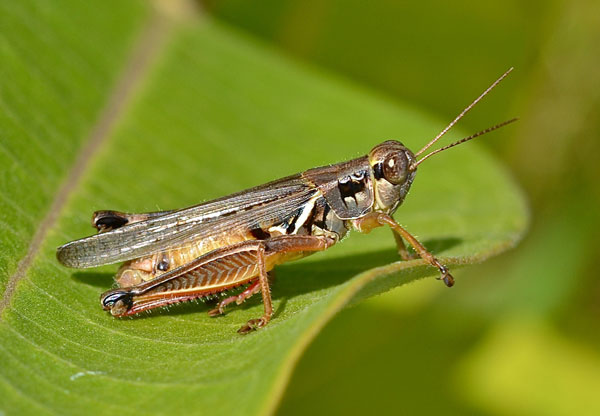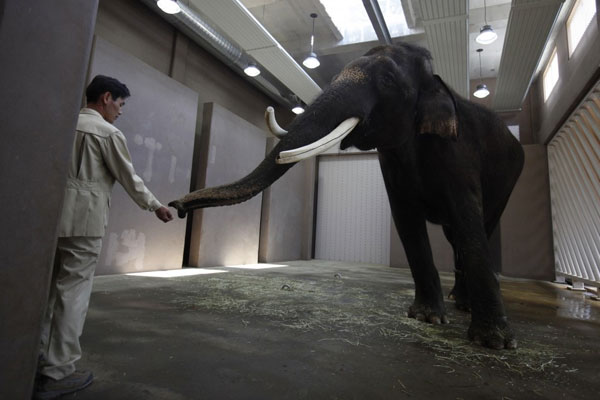Animals like humans
People are still considered the most advanced animal group with unmistakable features and features for any species. But it turns out, we still share a lot of things in common with other animals, even if there is no close relationship.
1. Ear grasshopper ears

People have ears with rather complex structures that convert sound waves into mechanical vibrations that the brain can handle. And surprisingly, the Katydid grasshoppers also have a similar system. According to a study published in the journal Science on November 16, this species of grasshopper species is very similar to human ears, with eardrums, parts that act as levers amplify vibrations and filled bags. fluid, where sensory cells are responsible for conveying information to the nervous system. Although a bit simpler, grasshopper ears can be heard better with a range farther than human ears.
2. Language resembles an elephant
It has long been believed that the complex language system belongs to only high-level animals. But this concept may have to change a bit when scientists find that elephants can also make sounds similar to humans.

That is the case of an Asian elephant named Koshik living at Everland Zoo (South Korea). It has learned how to use taps and throat to mimic human voices and can pronounce some words that are similar to indigenous people like 'hello', 'no', 'sit down', 'lie down 'and' good ', of course in Korean.
But according to the research team, Koshik does not understand the meaning of the words he 'says'. They think the reason is because Koshik has been at the zoo since he was 5 years old and the only elephant here. Meanwhile, 5-10 years old is an important development stage for elephants, perhaps the elephant has learned a human language to contact around.
3. Expressive face of a mouse
When in pain, our face will have a reflex reflex. In 2010, experts at McGill University and the University of British Columbia (Canada) discovered that on this point, mice were similar to humans. This study helps them know what can hurt rodents, thereby removing unwanted pain for them in the lab.
4. Say dreams like dolphins
While sleeping, dolphins can still "recite" the whale 'song'. According to the researchers, they gave five dolphins living in a marine conservation area in France to listen to the "whale song" recording throughout the day. Unexpectedly, at night, they seem to tend to mimic the sounds they hear during the day, a form of sleeping charm that is like a human being.
5. Octopus building skills

Octopus octopus (Amphioctopus marginatus) knows how to use coconut shells as a mobile shelter. Initially they lifted the coconut shell, used a tentacle to wipe the mud from it. When you want to move, the tentacles will grab half a piece of coconut shell and place it under your body, helping them leisurely surf the seabed.
6. The movement of starfish

It's hard to imagine that Brittle Star, a starfish creature, even without the central nervous system, has a human-like trait. The decisive factor is the strange part like the 5 arms combined moving smoothly.
The Brittle star body is symmetrical through the center, meaning that their bodies can be divided into matching halves by straight lines through the arms and central axis. Meanwhile, other humans and mammals belong to a two-sided symmetry group, meaning that the body can be divided into 2 with a straight line through the body, this side is a mirror image of the other party. Species that are symmetrical through the center hardly move at all or move up and down, just like a jellyfish when swimming. However, starfish is an exception, it can move forward, perpendicular to the body axis - a skill usually reserved for two-sided symmetry groups like humans.
- Science explains the difference between humans and animals
- What would happen if humans were ... 'cold-blooded animals'?
- Animals also know how to heal themselves like humans
- 15 cute animals but you have to stay away
- 10 most dangerous animals on the planet
- Should we humans eat meat?
- Animals look at objects that look like humans?
- 10 animals make humans extinct if revived
- How does a virus jump from animal to human?
- Solemnly for birds that are extinct by humans
- Strange question: Do animals laugh like humans?
- The more intelligent an animal is, the more he likes to tease humans
 Animal 'suffering' after hibernation
Animal 'suffering' after hibernation Why do goats climb well?
Why do goats climb well? Scientists were surprised to see chimpanzees eating turtles
Scientists were surprised to see chimpanzees eating turtles Giant catfish died deadly due to drought in Thailand
Giant catfish died deadly due to drought in Thailand